The global prediabetes market size is calculated at USD 300.42 million in 2025 and is forecasted to reach around USD 599.34 million by 2034, accelerating at a CAGR of 7.15% from 2025 to 2034. The North America prediabetes market size surpassed USD 123.17 million in 2024 and is expanding at a CAGR of 7.28% during the forecast period. The market sizing and forecasts are revenue-based (USD Million/Billion), with 2024 as the base year.
The global prediabetes market size was estimated at USD 300.42 million in 2024 and is predicted to increase from USD 322.14 million in 2025 to approximately USD 599.34 million by 2034, expanding at a CAGR of 7.15% from 2025 to 2034.
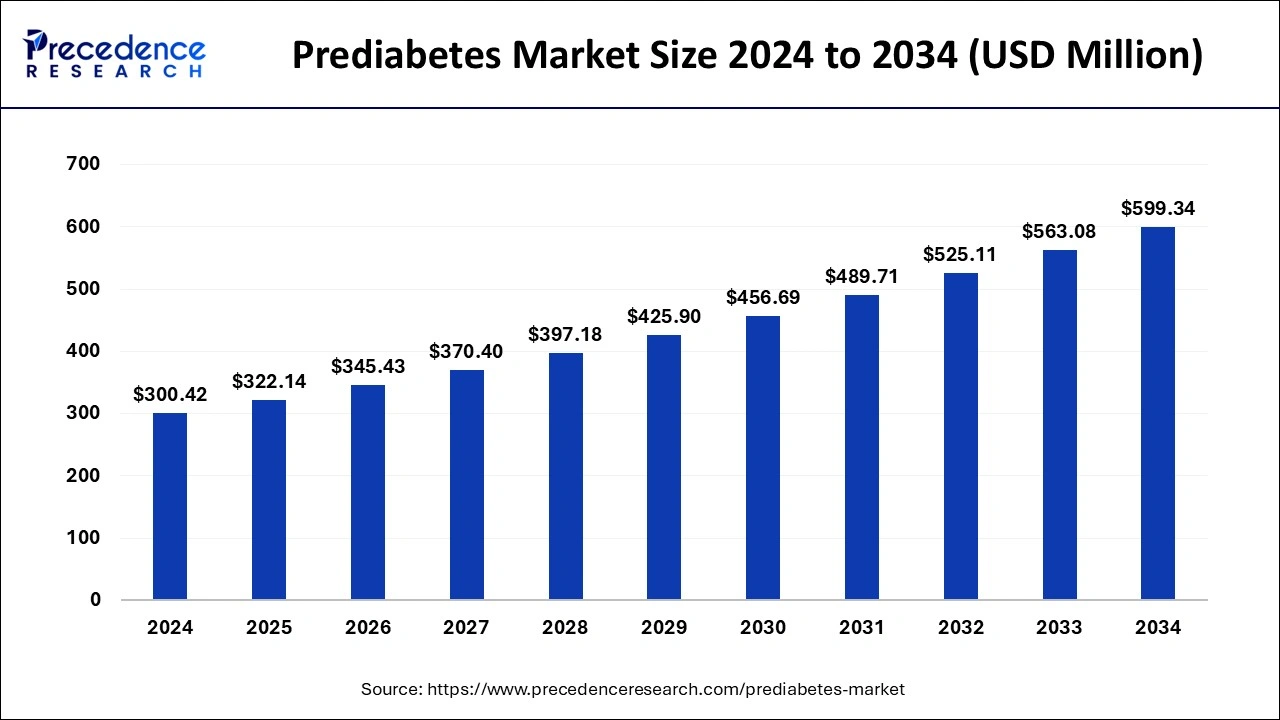
The U.S. prediabetes market size surpassed USD 110.85 million in 2024 and is projected to attain around USD 225.10 million by 2034, poised to grow at a CAGR of 7.34% from 2025 to 2034.
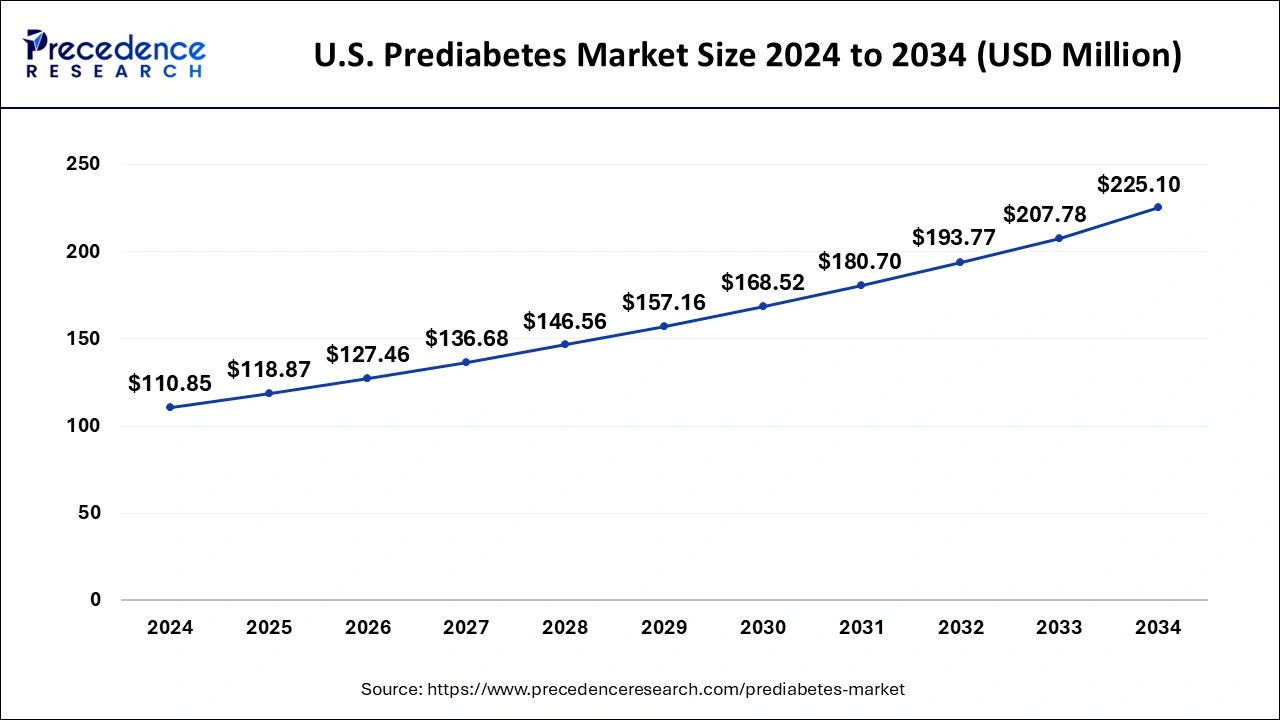
North America held the dominant share of the prediabetes market in 2024. The growth of the region is attributed to the presence of advanced diagnostics centers, rising adoption of sedentary lifestyles, rising aging population, increasing consumption of packed & junk foods, rising research & development activities, increasing prevalence of prediabetes, and favorable healthcare policies and initiatives of government focused on addressing prediabetes risk factors.
The rapid advancement in technology, including wearable devices and digital health platforms, is revolutionizing the prediabetes market by constant monitoring and personalized interventions. Moreover, there is growing awareness among healthcare providers and individuals regarding the significance of early detection and intervention of prediabetes. Furthermore, the surge in the cases of genetic predisposition & obesity are the major factors contributing to the growth of the market during the forecast period.
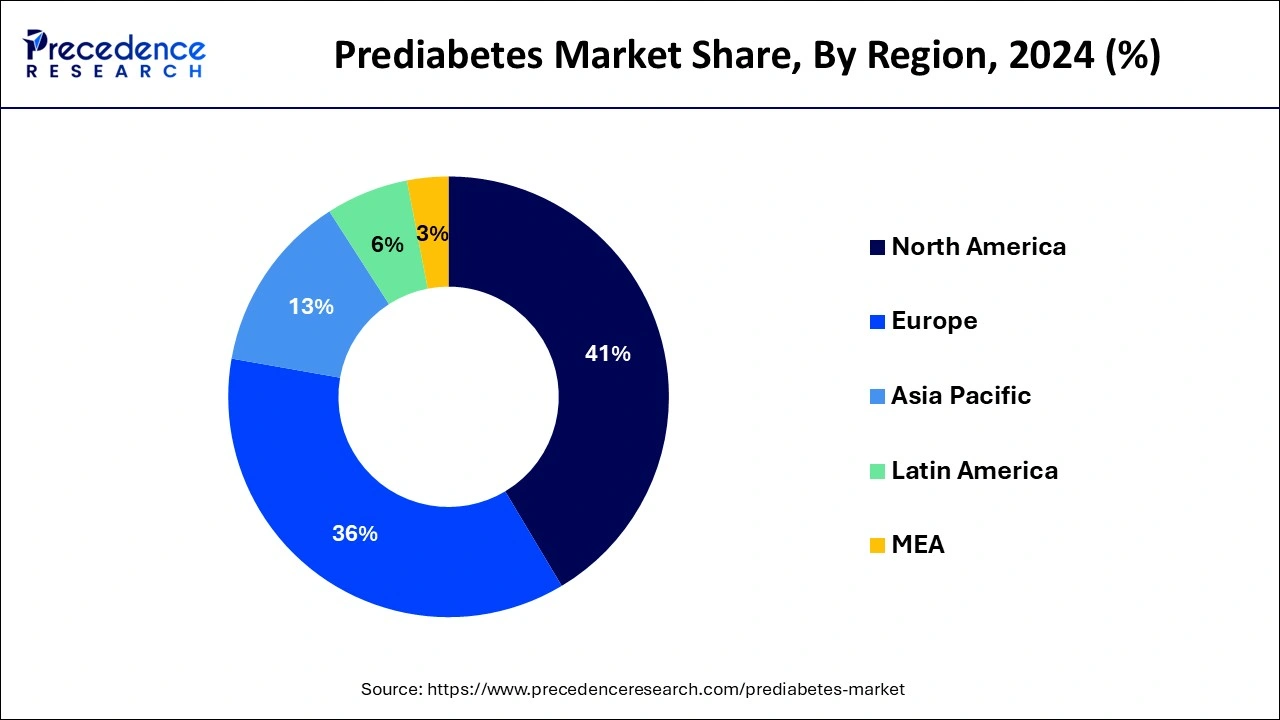
Asia Pacific is projected to expand at a rapid pace in the prediabetes market during the forecast period. The growth of the region is driven by the rising demand for diagnostic tests and screening services, the growing aging population, supporting government initiatives to prevent type diabetes, the rising adoption of inactive lifestyles, increasing cases of obesity, and rapid advancement in diagnostic technologies and therapeutic alternatives.
In prediabetes, blood sugar levels are higher than normal but not high enough to be considered as type 2 diabetes. The timely precaution and treatment for prediabetes can prevent several severe health conditions, such as type 2 diabetes and various related diseases in the heart, kidneys, and blood vessels. In prediabetes, eating healthy and natural foods, doing regular exercise as a part of their daily routine, and maintaining a healthy weight can assist in bringing the blood glucose level back to normal.
| Report Coverage | Details |
| Market Size in 2025 | USD 322.14 Million |
| Market Size by 2034 | USD 599.34 Million |
| Market Growth Rate from 2025 to 2034 | CAGR of 7.15% |
| Largest Market | North America |
| Base Year | 2024 |
| Forecast Period | 2025 to 2034 |
| Segments Covered | Drug Class, Age Group, and Regions |
| Regions Covered | North America, Europe, Asia-Pacific, Latin America, and Middle East & Africa |
Increasing prevalence of prediabetes
The rising incidence of prediabetes across the globe is anticipated to fuel the growth of the global prediabetes market during the forecast period. Diabetes is becoming a very common and lifelong disease. Prediabetes serves as a warning sign that an individual is at risk of developing diabetes if appropriate preventive measures are not taken on time.
Before developing type 2 diabetes, an individual suffers from prediabetes. Prediabetes is also commonly known as borderline diabetes. It is considered a serious health problem and requires early action to reverse prediabetes or prevent type 2 diabetes. In this health condition, the blood sugar level is higher than normal but not high enough to define diabetes.
Obesity is considered a significant risk factor for developing prediabetes and is often associated with the consumption of junk food, poor diet, and sedentary lifestyles. People with prediabetes are advised by doctors to manage body weight, maintain a healthy diet, and regular exercise. In some cases, people with prediabetes often have a genetic link in which their family members are diagnosed with type 2 diabetes.
Additionally, the Government and several NGOs are spreading awareness through public health campaigns and educating people that prediabetes can be reversed by early detection and preventive measures. Thus, the prediabetic population and their expenses on glucose monitoring devices are also growing significantly, which is anticipated to propel the growth of the prediabetes market.
Lack of awareness
The lack of awareness is anticipated to hamper the growth of the market. The less awareness regarding timely precautions and changes in lifestyle in underdeveloped countries may result in serious health conditions. Several middle and lower-income countries lack advanced diagnostic infrastructure, which is likely to restrict the expansion of the prediabetes market.
Rising geriatric population
The growing aging population is projected to offer a significant opportunity for the growth of the global prediabetes market in the coming years. The rising aging population is highly susceptible to diabetes. Glucose monitoring devices are becoming increasingly popular among the geriatric population to prevent diabetes with a healthy diet and yoga or exercise. Therefore, a rapid surge in the aging population globally is expected to contribute to the growth of the prediabetes market.
The diguanide segment accounted for the dominating share of the prediabetes market in 2024. The growth of the segment is driven by the rising adoption of metformin for effectively managing prediabetes and type 2 diabetes health conditions. Metformin is classified as a biguanide drug and is a widely used drug for prediabetes treatment and slowing down the progression of prediabetes. It reduces blood glucose levels by decreasing glucose production and enhances insulin sensitivity.
The SGLT2 Inhibitors segment is expected to witness significant growth in the prediabetes market during the forecast period owing to the increasing cases of prediabetes. SGLT2 Inhibitors are extensively used for the treatment of prediabetes and diabetes. SGLT2 inhibitors are a class of drugs prescribed to lower blood sugar by causing the kidneys to remove an increased amount of blood sugar from the body through urine and reduce the blood sugar level.
The adults (18-49) segment held the largest share of the prediabetes market in 2024. The individuals belonging to these age groups have the highest prevalence of prediabetes due to their unhealthy diet and sedentary lifestyles. Such factors drive the growth of the segment during the forecast period.
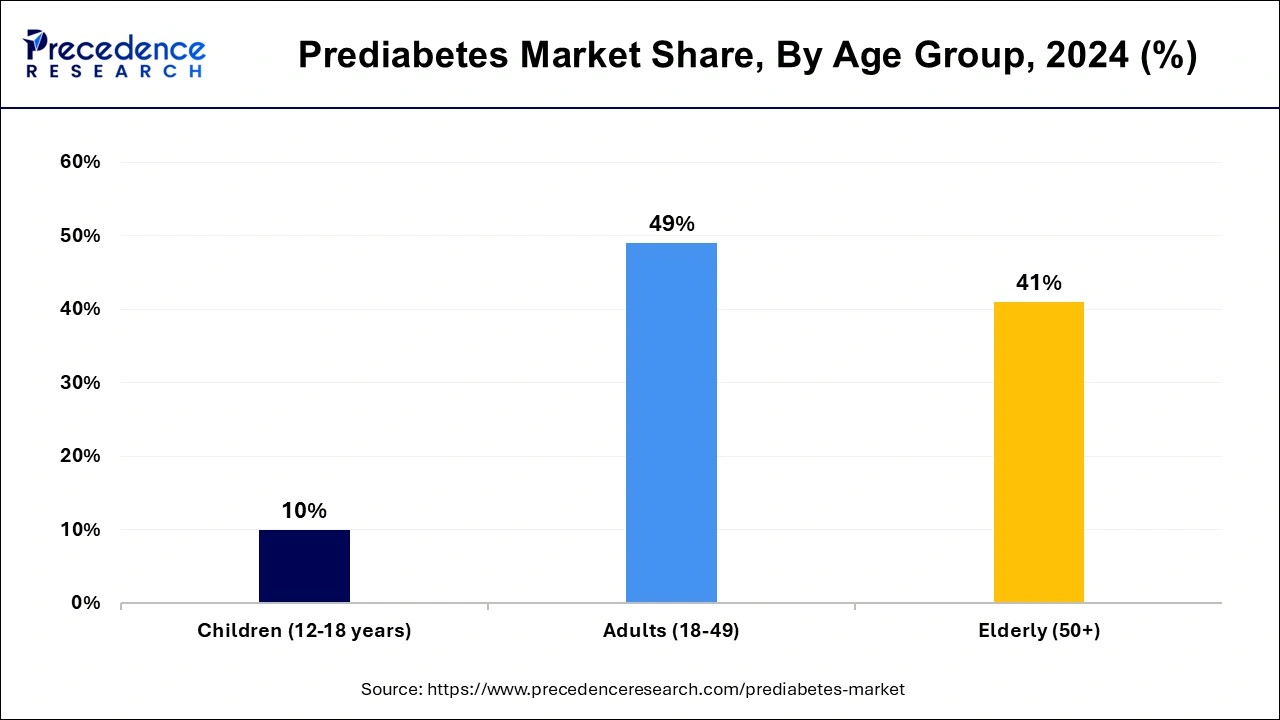
The elderly (50+) segment is expected to expand robustly in the prediabetes market during the forecast period. This age group of people is prone to age-prevalent illnesses such as type 2 diabetes. Furthermore, the surge in the geriatric population globally led to an increasing demand for prediabetes medication. Thereby bolstering the segment’s growth.
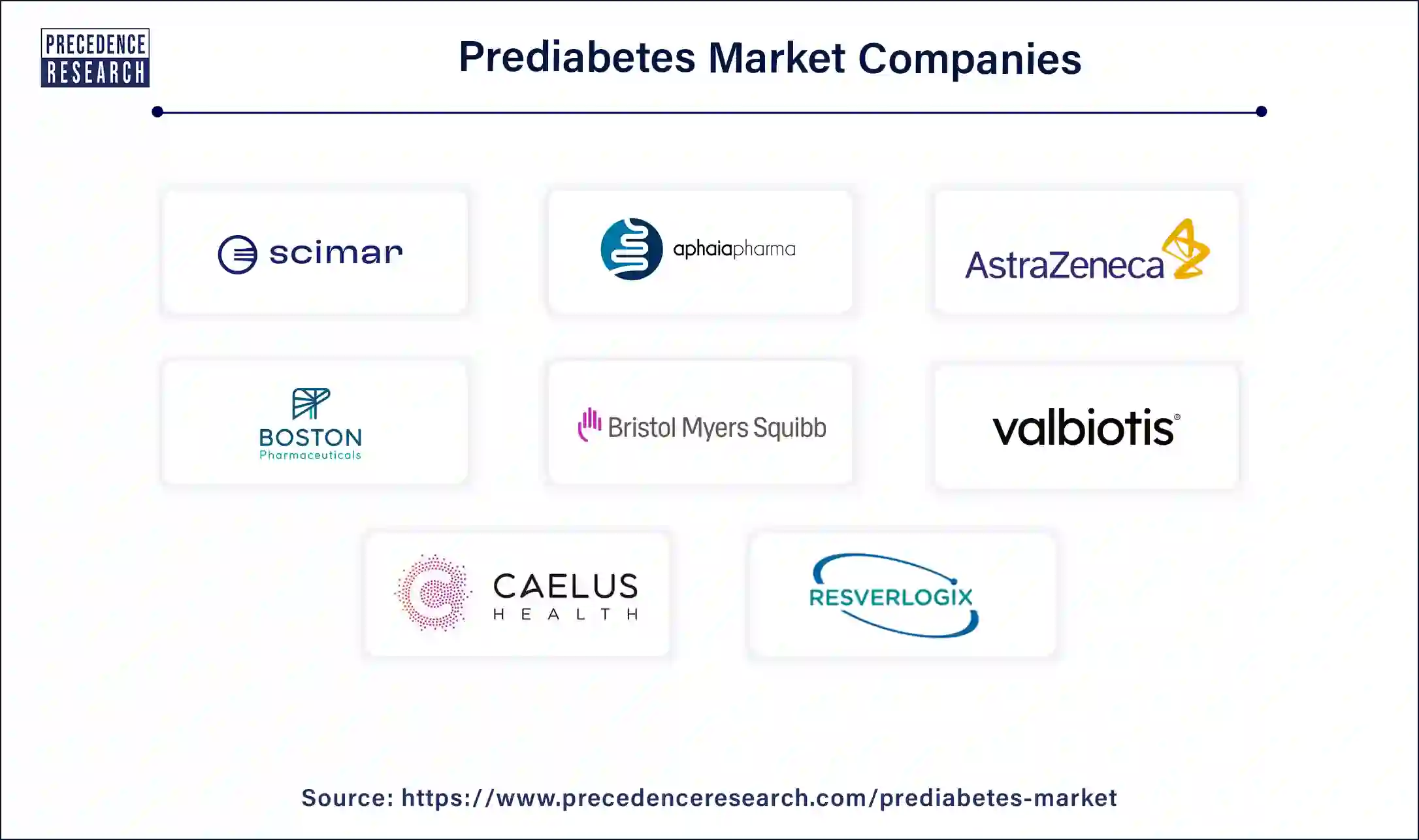
By Drug Class
By Age Group
By Geography
For inquiries regarding discounts, bulk purchases, or customization requests, please contact us at sales@precedenceresearch.com
No cookie-cutter, only authentic analysis – take the 1st step to become a Precedence Research client